Lecture
In 1971-1975 microcomputers with great difficulty conquered the bridgehead from the mainframe , acquiring, in the end, its own operating system (CP / M) and programming language ( Basic ), as well as coming to the idea of a universal bus (S-100) and extensibility. But then, starting around 1976, manufacturers gradually abandoned the sale of self-assembly kits, having come to the obvious thought that the user is eager to deal with factory-made PCs, preferably with peripherals and software.
This is how second-generation personal computers appeared: with already installed / built-in keyboards, a monitor (or with the ability to connect to TV), storage devices and Basic in ROM. In fact, the computer Apple] [Plus, which appeared in 1979, already "looked into the future", it was not by chance that the Apple series] [existed until 1993
At the end of the 70s, another, very important shift occurred - for personal computers, operating environments, business applications and video games began to be written in much larger numbers than before. The power and availability of second-generation PCs have given a powerful impetus to the development of the gaming industry, as well as the software industry.
However, such a breakthrough in the PC market is not only the business of the creators of Apple. Other nice "cars" said their weighty word in the history, among which stood out: Sol-20, TRS-80, Commodore PET, Atari 400, Atari 800, Texas Instruments TI-99/4, Heathkit H89, Bell & Howell and of course, the unforgettable Apple] [.
Sol-20 Terminal Computer
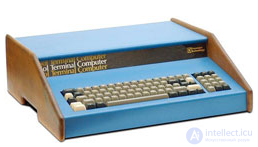
Sol-20 Terminal Computer
This computer from the company Processor Technology went on sale in June 1976 at a price of $ 2,129 (a set for self-collection cost $ 995). The roots of Sol-20 go back to Sol-PС, which represented a simple motherboard without a power supply and case (with this configuration, by the way, began the history of Apple computers - for that time it was the norm).
Sol-PC was sold at a ridiculous price ($ 475 per set), but times change, and users were mentally prepared to pay extra for a fully equipped PC, just not to mess around with a soldering iron and a multi-page manual. This is how Sol-10 appeared, and after Sol-20 itself.
A distinctive feature of the Sol-20 was a built-in keyboard, as well as side panels made of natural walnut. The computer used the then popular S-100 bus (first introduced on the Altair 8800 computer in 1975) with five expansion slots. The “heart” of the Sol-20 was an Intel 8080 processor with a clock frequency of 2 MHz. The amount of RAM was 1 KB (standard; expanded to 64 KB). Cassettes popular at that time could also be used as drives, since they were cheap and widely distributed.
But the tapes had big drawbacks - sluggishness and problems with the correct loading / saving of information. However, optionally a Sol-20 floppy disk drive could also be connected, specifically for 8-inch floppy disks. In particular, a curious Helios II Disk Memory System drive, designed for installing two 8-inch floppy disks, was sold for Sol-20. The drive cost more than the computer itself - $ 2,295, but the assembly kit was implemented "only" for $ 1,895. But on one diskette fit 384 kb of data.
Sol-20 used the operating environment as CP / M (Control Program for Microcomputers), as well as Basic.
In total, about ten thousand computers of the Sol family were sold (most of the sales came from the hit Sol-20).
TRS-80
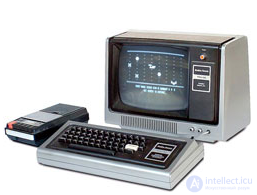
TRS-80
Released by Radio Shack in August 1977, this computer had an incredible success, as indicated by sales results - in one month ten thousand copies of the TRS-80 (Model I) were sold. What is the secret of such success? For only $ 599.95, the user received both a high-performance computer (Zilog Z-80A, 1.77 MHz was used as a CPU), and a 12-inch monochrome monitor, and a cassette drive! The person bought the TRS-80, connected it to the network and started working.
In some ways, the TRS-80 could be called a computer for beginners, because in the standard configuration it was quite a modest computer. Therefore, more experienced and sophisticated users additionally purchased (for $ 299) a special expansion module that was installed under the monitor, which contained a port for connecting a printer, a floppy disk controller (up to four), additional RAM (up to 32 KB) and much more.
The success of the first model (Model I) affected the further longevity of the whole TRS-80 family. In October 1979, a PC called the TRS-80 Model II appeared, and in July 1980, Radio Shack introduced three different models: TRS-80 Model III ($ 700-2500), TRS-80 Color Computer ($ 400) and TRS-80 Pocket Computer ($ 230). The 1982 model of the TRS-80 Model 16 with 8-inch floppy drives and an optional 8 MB hard disk drive turned out to be curious.
Commodore PET

Commodore PET
Almost simultaneously with the TRS-80, in June 1977, the famous Commodore PET (the Personal Electronic Transactor), model PET 2001 became available to a wide range of users. It sold for $ 795, offering a nice configuration for the money: CPU - MOS MSC6502 , 1 MHz; RAM - 4 KB (in later versions of the computer - 8 KB), built-in tape drive, built-in 9-inch monitor, IEEE-488 port and Basic programming language.
PET 2001 had a number of notable features. First, it was assembled on the basis of the then popular processor MOS MSC6502. Computers like the Jolt, Atari 400, Atari 800, Bell & Howell, AIM-65 and, of course, Apple were created on this 8-bit chip.]. The chip mentioned above won special love among PC makers due to its incredible low cost - MOS Technology sold it for $ 25. For comparison, Intel estimated its i8080 chip at $ 300. PET 2001 had a built-in cassette drive, which gave more convenience when working with it. And, thirdly, the keyboard is also built-in. Today it can be compared to miniature keyboards of pocket PCs.
Atari 400
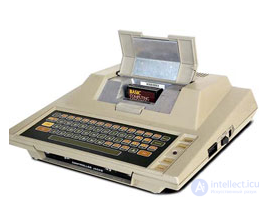
Atari 400
Computers of the Atari family have made a great contribution to the development of the gaming era of computer engineering. The monitor, which very quickly became a standard part of a personal computer configuration, allowed us to fully enjoy not only the programming or costing of income, but also a virtual game. It is not by chance that the Atari 400 was already targeted at a teenage audience, which was reflected in the design and in the built-in reader of game cartridges. Of course, cartridges (like cassettes) could serve to launch more serious programs, for example, the same BASIC, since when you started from ROM at Atari 400, you could run only "Notepad".
Atari 800

Atari 800
Despite the announcement in December 1978, the Atari 400 was released only in November 1979, like its more advanced fellow Atari 800. The first cost $ 549.95, the other - $ 450 more. Standardly, the Atari 800 had 8 KB of RAM (expandable up to 48 KB), four internal expansion slots, two cartridge readers, TV-video and RGB-video outputs, as well as a controller for connecting an Atari 810 external floppy disk drive. -inch diskettes with a capacity of 90 KB.
The presence of co-processors for processing graphics and sound made the Atari 800 an excellent gaming machine, since the MOS 6502 itself did not experience overloads.
Finally, the Atari 800 had an Atari 820 matrix printer that prints at about 40 characters per second. Both the floppy drive and the printer had their own chips, which also reduced the load on the main chip in the computer. They could also connect to the Atari 400.
At that time, floppy drives were very expensive (hundreds of dollars), so there were regular tapes in wide use. For this reason, many cassettes were released, not only with programs, but also with games, specifically to run on the Atari 400/800.
Texas Instruments TI-99/4
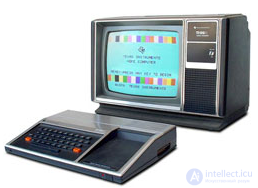
Texas Instruments TI-99/4
It was the first computer of the company Texas Instruments (released in November 1979), and it was a success for the glory - at least, it looked impressive. And all thanks to the 13-inch color monitor, which was played by a converted Zenith TV. By the way, due to the fact that Texas Instruments did not have the legal ability to integrate an RF modulator so that everyone could connect the computer to the TV, the TI-99/4 was only sold with a monitor, which naturally affected the final price ($ 1,150). Prior to TI-99/4, the company was engaged in the release of calculators, which is noticeable on the built-in keyboard. By the way, the inconvenient keyboards of many PCs of the second half of the 70s were not uncommon, it was not by chance that subsequently personal computers began to be equipped with external keyboards.
In general, the TI-99/4 was quite a serious machine, it had a slot for installing cartridges, a cassette drive, audio / video outputs, a joystick port, and also peripherals — a speech synthesizer, a thermal printer, and a 5-inch floppy drive. Thanks to the RS232 interface, it was possible to connect a modem.
As a processor TI-99/4 used TI TMS9900 with a clock frequency of 3 MHz. RAM was 16, and ROM-memory - 26 KB.
In order to reduce the price, in February 1981, Texas Instruments changed the monitor: from Zenith to 10-inch Panasonic, winning about $ 50.
In June 1981, an upgraded version of the computer - TI-99 / 4A Home Computer. In July 1983, Texas Instruments shipped the millionth TI-99 / 4A, which, however, did not help it to linger long on the home computer market. Another fact is curious: at the beginning of 1982 three engineers left the company, dissatisfied with their position, (Bill Murto, Rod Canyon and Jim Harris). They formed the company Compaq Computers, which was destined to create the first IBM PC clone - Compaq Portable.
Heathkit H8 / H89 / WH89

Heathkit H8 / H89 / WH89
About Heathkit personal computers became known in the second half of 1977 - the H8 model was based on the i8080A chip (2 MHz) and offered a panel of nine LEDs as an interface. The H8 was also distinguished by the fact that it used not the popular S-100 bus, but the original "Benton Harbor" bus with ten expansion slots designed for installing 50-pin motherboards. Thus, compatibility with other PCs, as they say, does not even smell. His was and the operating environment - HDOS (Heath DOS).
In 1979, the H89 model appeared, which fully responded to the then all-in-one fashion, that is, it had a built-in keyboard, a monitor (12-inch, monochrome) and a cassette drive. The great advantage of H89 was that the MTR-88 'monitor' embedded program was placed in its ROM, which allowed working at a computer without additional software download from a tape or diskette. Among other software, an assembler, a text editor, and two types of BASIC (Microsoft and Bentor Harbor) were also supplied with H89. The Zilog Z80 (2 MHz) was used as a processor, the RAM was 16 KB (maximum - 48 KB).
The WH89 version tested and assembled at the factory cost $ 2,295 (the H89 in the kit was $ 700 cheaper). Soon, Heathkit was swallowed up by Zenith Electronics Corporation, which founded on its basis a division of Zenith Data Systems, which took up the issue of PCs under the Heath / Zenith brand and, in fact, Zenith Data Systems.
Interestingly, in 1989, this division was acquired by the French computer company Groupe Bull, which at one time (under the name CII-Honeywell-Bull) absorbed R2E, which created one of the first microcomputers in the world - Micral (1973). As a result, in 1980, the Micral 80-22 appeared, which also worked on the Zilog Z80 chip, and used Prologue as one of the operating systems (besides CP / M).
Apple I
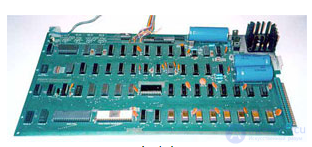
Apple I
Back in 1976, to the origins of the birth of Apple Computer. We are not without intent to put a story about the first Apple computers at the end of this story, so that readers can familiarize themselves with all the most significant PC models from other manufacturers in the second half of the 70s. Then it will become clear that Apple I and Apple] [(namely, the original spelling of the second “apple”) did not stand out from the competition, but the planned, well-thought-out development of the platform led to a quick market seizure and shame of opponents.
A lot of materials have been written about the history of Apple Computer and its creators, Steve Wozniak and Steve Jobs, so we will not dwell on this topic in detail - we will limit ourselves to key points. So, the engineer at Hewlett-Packard, Woznia, Wozny, was in love with computers, and in the end, he managed, thanks to the low cost of the MOS MSC6502 chip, to create his own PC. However, you will be mistaken if you think that this creation was at least as close as a modern computer. No, the brainchild of Wozniak fully responded to the spirit of its time, representing a regular fee for lovers of self-collection.
Apple I provided for connecting the keyboard, tape drive and monochrome display. The computer on board carried 4 kb of ram. There was one expansion slot. This creation Wozniak took to the computer club "Homebrew", so that its members could appreciate the efforts of Steve. But Wozniak was disappointed; perhaps only one Steve Jobs, a longtime friend, became seriously interested in his development. Jobs' interest, which had a remarkable entrepreneurial spirit, was a turning point in the life of not only Steve, but also the entire computer industry.
April 1, 1976. Wozniak, Jobs and Ron Wayne founded Apple Computer. Whether from superstition (April 1 - April Fools' Day), or from disbelief in success, but Wayne after 12 days hastily left the company, taking $ 800 as compensation, giving up his 10% share in return. Of course, there was a risk, because Jobs managed to get a loan in the amount of $ 15,000, which had to be returned a month later! A loan was needed - Paul Terrell, the owner of the computer store "The Byte Shop", was ready to buy 50 Apple I at once ($ 500 for each computer), but with the condition that he would be provided with fully assembled, ready-to-use machines. In a hurry, in the garage of Jobs' parents, two Steve drew and tested computers day and night. They had time, and to the wide consumer in July 1976, the Apple I went at a strange price of $ 666.66. The entire set of Apple I was sold, and all were collected about 200 such computers.
Apple Plus

Apple
On the job, Steve Wozniak started creating a more powerful computer. The processor remains the same, but there were plenty of innovations. This eight expansion slots, and graphics mode (six colors in high resolution 280 x 192, and 16 colors in the resolution of 40 x 48), and a stylish plastic case with built-in keyboard. Apple] [appeared in April 1977 and cost $ 1,298 in a configuration with 4 KB of RAM.
If you compare Apple] [with computers released in the same year (Commodore PET and TRS-80), you can see that in the original version the “second apple” did not have clear advantages over competitors, and there’s no difference in price . If we talk about the Basic language stored in ROM-memory (which made it possible to work instantly at a computer without connecting external drives), then its Basic version was "embedded" in the ROM and from Commodore PET, while TRS-80 required to purchase a module extensions (see above).
Apple really stood out] [the number of expansion slots, which made it a flexible tool to work and ... play. Without exaggeration, we can say that it was the emergence of Apple] [which sharply spurred the development of the gaming industry — making games was not only interesting (for lone programmers), but also profitable (for companies). High performance, color graphics and four game ports ("Game paddle") provided an excellent opportunity to enjoy the gameplay - virtual reality began to drag out an increasing number of gamers.
Of course, Apple was not only for entertainment] [. The simplicity of handling a computer with the help of a small number of simple commands (there was no need to cram a programming language) made Apple] [a true friend and indispensable assistant to a wide range of users.
However, Apple] [could have remained “one of the number of others” if the idea of the company’s leaders had not come forward by leaps and bounds. At the end of the brilliant year 1977, Apple Computer chairman of the board Armas Cliff "Mike" Markkula had a list in front of him in which the "floppy" was in first place on the importance of implementing the new version of Apple] [. In June 1978, an external disk drive appeared [], which operated with more modern 5-inch floppy disks (5.25 ") with a capacity of 143 KB, and cost only $ 495, which put it almost out of competition in the market of drives. The creation of a floppy drive (Wozniak was the author of the controller) led to the emergence of the Apple DOS operating environment, it was needed to operate the floppy file system. There is no doubt that the appearance of the Disk II and Apple DOS drives brought Apple] [to the leaders of the computer market; It became especially popular in business structures, because in the face of diskettes business people received an excellent tool for storing, reading and sharing information.
Together with diskettes and OS came (and could not help but come) a variety of applications that helped to type texts, count incomes, etc. Among those in 1979, the VisiCalc spreadsheet appeared (developers: Dan Bricklin , Bob Frankston). Modern users will immediately become clear about what is at stake, if we mention the Excel program from Microsoft. Not surprisingly, the version of Apple] [Plus was a stunning success. From now on, computers, on which the logo with a bitten apple flaunted, became an integral part of the educational process (Apple's position was particularly strong in US educational institutions), printing, business, and, of course, home interior. However, not so much time will pass when Apple computers will be called “computers not for everyone,” but we will tell about this amazing metamorphosis (and many other things) another time.
Comments
To leave a comment
History of computer technology and IT technology
Terms: History of computer technology and IT technology